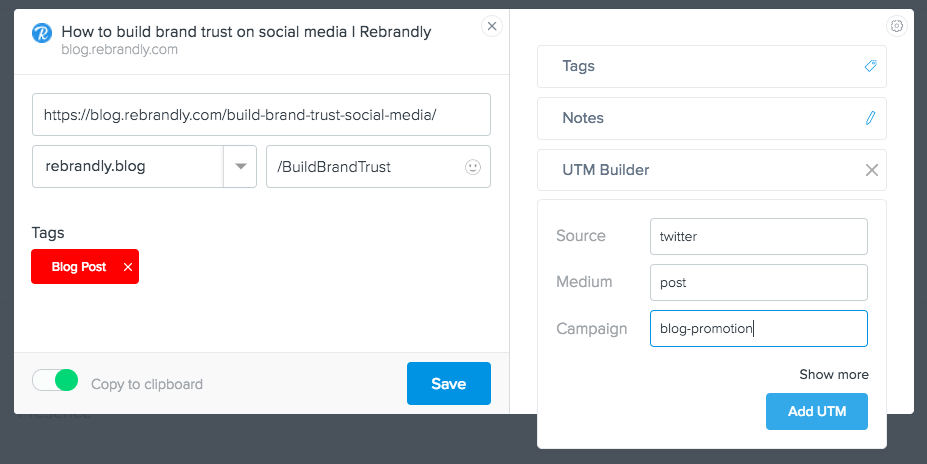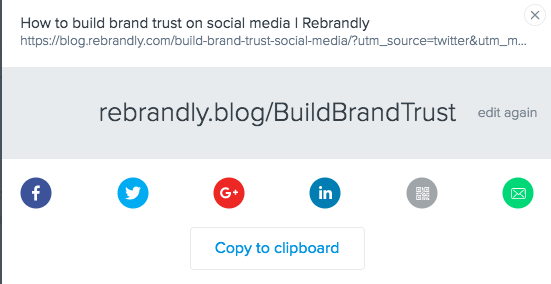UTM Parameters Explained: a Marketer’s Guide

Thank-you to Louisa McGrath, content manager at Rebrandly, for this article. Rebrandly is a URL shortener empowering marketers to put their brand directly on their links.
UTM stands for Urchin Tracking Module. I know what you’re thinking – huh?
Though it sounds complicated, using UTM parameters is actually deceptively simple and is something that can really up your marketing game. Attaching UTM parameters to the links you share is essential if you want to accurately track and attribute your digital marketing activities. Something that many marketers consider essential.
At times they can be a bit of a hassle, as creating the parameters can slow you down when you’re eager to share that great new blog post you just wrote. But they are a dark necessity and those couple of seconds that it takes to add UTM parameters to the links you share will give you accurate and informative insights. They will let you know which marketing activities are worth investing resources in, saving you time in the long run.
So, in more detail, let’s run through why and how your marketing team should use UTM parameters.
But first, what are UTM parameters anyway?
Covering the basics
Urchin Tracking Module parameters, also known as UTM tags or labels, are short snippets of code attached to the end of a URL.
This is an example of a link without UTM parameters: blog.rebrandly.com
Here is a link with UTM parameters: blog.rebrandly.com/?utm_source=facebook&utm_medium=post&utm_campaign=promote-blog
This extra snippet of code allows you to track information about the visitors that come to your site through that link. You can see where someone came from and what they clicked on to bring them there. With this information at your fingertips, you’ll be able to discern what marketing messages are most effective and figure out which visitors to your site offer your business the best ROI.
The analytical insights of UTM parameters explained
With so many analytics tools and metrics to track, it can be hard to make the connection between what social media posts or traffic sources lead to the most conversions.
Once UTM parameters are attached to a URL, the data from your links is stored inside the tool you’re using to track your website’s performance, be it Google Analytics, DashThis, or both. This will let you easily track your off-site and on-site marketing efforts through to conversion.
In your analytics tool, you can sort out your Source/Medium stats. You’ll be able to see which channels and marketing campaigns are making the most impact. With this knowledge, you can then make educated choices when it’s time to allocate your marketing budget.
There are five parameters that you can attach to your links, but for most marketers just three are essential:
Source: Add this tag with the name of the place you will be putting the URL and this will let you monitor exactly where your traffic is coming from. For examples, you can use tags like “facebook”, “twitter”, or “quora”.
Medium: This parameter is used to represent the type of content you are sharing the URL in. You could tag your links with words like “post”, “blog-comment” or “quora-answer”.
Campaign: This tag represents the marketing campaign the link you’re sharing is part of. For example, you might add a tag like “summer-promotion” or “black-friday”, this way you can easily see which campaigns did well.
So for a link you plan to share a blog post on Twitter, you might add UTM parameters where the source is Twitter, the medium is post and the campaign could be called blog promotion.

When someone clicks on a link, the UTM parameters you’ve chosen will appear in the address bar, so be careful. Don’t use nasty keywords, passwords or other private information in your parameters. Parameters like “some-idiot-clicked-my-link” will probably get you into trouble.

The two other UTM parameters aren’t used as frequently, but can be useful for large campaigns or paid ad campaigns. These are:
Term: This parameter is used to track the keyword used in an ad. This is particularly handy for differentiating between keywords used in Google AdWords ads.
Content: For this tag, include the keyword in the headline of an image ad, or the topic of a Facebook ad. For example, your call to action could be “Download eBook” or “Subscribe Now.” With this parameter, you can monitor which CTAs convert best.
Though tracking traffic with UTM parameters takes some commitment, it gets easier the more you do it, because in most UTM builders, like Rebrandly’s, presets can be saved. And if you’re using an automated dashboard, like DashThis, to view your marketing data, you can easily filter your results by the various UTM parameters you’ve created. This will allow you to only see data related to your chosen parameters.
Why marketers should use UTM parameters
UTM parameters are all about figuring out where your web traffic comes from, but it can be used in a range of other ways too.
To give you better insight into where your visitors come from, UTM parameters can help you separate out the traffic you send to your site, from the traffic others send to your site. It’s easy to forget that 10,000 visits coming from social media doesn’t necessarily mean your social media marketing is spot on. These visits could be due to your activities – or due to activity on other people’s accounts.
UTM parameters can also be used to accurately track direct traffic. Sometimes when people come to your site, the referral parameters are lost, so it can seem like you’re getting more direct traffic than you really are. The “direct” traffic in Google Analytics can mislead you, but with UTM parameters, the analytics will be exact.
Marketing teams use lots of different methods to drive traffic to their website. From backlinks, to videos, webinars, blog posts, emails, blog commenting, and email signatures. The list goes on. Once you’ve filled in your ‘medium’ parameter correctly, you’ll see clearly which types of content are paying off for you.
Beyond tracing traffic, UTM parameters could also be used to separate out efforts based on who did what. If you’re working with a team, add names or initials to links to track each member’s efforts. This isn’t about bragging rights or having an excuse to fire someone, but about following up with people when something goes well to ask them what they did to get that result.
For links that aren’t sending traffic to your own website, there is no need to add UTM parameters. This could help other marketers track their efforts, but they’re unlikely to care too much about the clicks you send their way.
However, in the case of marketing partners or affiliates, this can be useful. Or if you want to grab the attention of potential partners, this might make them take notice.
Some tips for using UTM builders
Lots of people use UTM parameters, but often they don’t use them quite right.
Once you’ve added parameters to a URL, always shorten it by creating a generic short link or a branded link, so you can present a visually pleasing URL to customers, rather than an atrociously long string of words. You can do this easily with Rebrandly’s UTM builder or DashThis's UTM campaign builder.
>
When using UTM parameters, it’s also a good idea to set yourself some rules, to keep the data organized. It’s best to always use lowercase letters. If you set the source parameters of your links as ”facebook”, “Facebook and “FaceBook”, they will be all be logged as different sources in your analytics tool and you’ll have to combine this data later.
You’re best to stick to lowercase letters, using hyphens or dashes between words and keeping your keywords consistent. Using long form words in your parameters is often the easiest way to keep them consistent, because code words or nicknames can be hard to remember. You don’t want to have to check the correct keyword every time you want to add UTM parameters to a link.
A key piece of advice is to never use spaces. They aren’t allowed in URLs and when one is used, it will turn into a messy looking “%20”.
UTM parameters play an important role when it comes to tracking results. They don’t affect SEO negatively, and they provide lots of benefits and insights for very little effort. Improved tracking capabilities will be available in Google Analytics, DashThis or wherever you choose to track your analytics. The accurate data will allow you to make smart decisions on where to invest your marketing team’s time and budget, which should result in an improved ROI and a better conversion rate for your business.
Speaking of amazing insights for little effort… DashThis is an amazing marketing reporting tool that allows you to track all your most important KPIs (including your links), assembling data from over 30 integrations, in one simple, beautiful, report. Ready to see what you can do?
Ready to automate your reporting?
Read More
Don’t miss out!
Automate your reports!
Bring all your marketing data into one automated report.
Try dashthis for free
